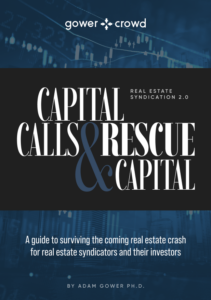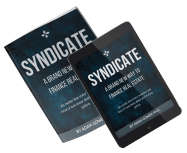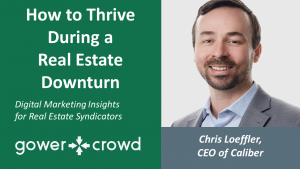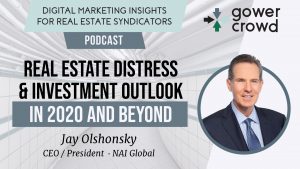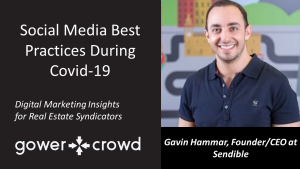Podcast Episode 313: Kendall Krawchuk, VP Marketing, Fund That Flip
Real Estate Syndication, Mastered

Fund That Flip is a technology, real estate and financial services platform that creates new opportunities for investors to take advantage of the the kinds of returns real estate can provide.
Plus, they help re-developers access a new source of capital so they can focus on what they do best – finding and rehabilitating homes.
Marketing to these two different audiences via the same platform requires finesse and advanced expertise and Kendall manages both with aplomb.
See below for more links to Kendall and to Fund That Flip.
What You're Going to Learn
* The trick to reading non-verbal communication cues online
* The digital follow-up process
* Dynamic response messaging
* When to move from digital to in-person contact
* Deciding which is the most effective social channel
* Why quality not quantity matters (post better, not more)
* How to crack the social code
* Do this 1 thing to get ahead of your competition
* How to find you ideal investor
And much, much more.
Listen To or Watch the Full Podcast Here
Show Highlights
When to Move From Digital to In-Person Contact
Adam Gower: You built systems. You built these emails and pre-authored all these emails, so that when somebody trips over a particular writing, or a particular whatever you want to call it, the lead score ... They hit a certain level in that lead score that your CRM, your email system, automatically communicates with them.
At what point then do you actually proactively have a warm body contact a prospect, or do you only wait for incoming? Is that how you structure it? Do you encourage people to contact you directly, or are you proactive in that regard?
Kendall Krawchuk: It's a great point, Adam. You're right, we've actually built on the back end, within our CRM, we have built what we call automated workflows, wherein if they come across that trigger or that inflection point where they show that they match the profile of the newbie, then it will automatically send out an email - what we call a nurture campaign.
It's often a series of maybe three to six to 12 emails, and often, it's not just all in one sequence. The idea of nurture is that you nurture that lead over time. You can do this all automatically and at a massive, scalable level. If it's a Newbie Nick - let's say that's our persona - we often give him a name so that he's a little bit more [cross talk]
Adam Gower: He's a guy, right? He's a guy in your case, right?
Kendall Krawchuk: He's a guy.
Adam Gower: Your avatar is a guy.
Kendall Krawchuk: Yes. In the case of our ideal customer, the Full-Time Francine ... I wanted to make her a woman, so ...
Adam Gower: Okay, good.
Kendall Krawchuk: On the back end, we're able to automate these marketing sequences, and, like I said, it's multi-channel. We could do email marketing; send out a couple of emails maybe over six to 12 months to Newbie Nick.
In addition to that, the tools are so advanced; it's so cool at this point. You can also take that contact information and upload them into a list wherein they are also marketed to across different channels.
Bringing it back to social media, you can re-market to them on Facebook, on LinkedIn, on Twitter. You're really able to take a multi-channel approach based on the strategy that you want to do with that type of persona.
Deciding Which is the Most Effective Social Channel
Adam Gower: ... who clicks on your ad, for example, but doesn't complete the form in any way, shape, or form, you can re-market to them, as well. You can identify who has interacted with your online ad, and then send them more information, presumably until they do respond.
How do you do that? Are you guys typically just Facebook, or Google? You talked about LinkedIn. Do you advertise on all channels? How do you decide which are the most effective?
Kendall Krawchuk: It's a great question, Adam. What's so cool about digital is, like we talked about in the beginning a little bit, is that it's all trackable. There's so much data to gather that you can really come into your strategy with a thesis and test it out.
For us, figuring out the social-media channels that made the most sense was really a lot of trial and error, and starting with a thesis around who our customer was, or who were the people that we wanted to engage - not just customers, but stakeholders, maybe, for example, people in NPR, or other types of stakeholders that would be interacting with your business.
After some trial and error, we figured out that what made sense was to come to each social-media channel with a thesis around who are the people that we believe are active on LinkedIn? Do we think it's our borrowers? Do we think it's people that are passively investing in real estate? What are the "watering holes" for each individual audience that we engage with as our business?
As I said. it was a lot of trial and error. What we then did was we ran tests on each of these social-media platforms. For example, we would run a four-week targeted marketing campaign messaging around one particular type of audience.
For example, on Facebook, we started off attempting to reach passive investors on there with a particular type of messaging. We ran a test over four weeks, and we said this is how many clicks we would expect to get. This is how many leads we would expect to get from this campaign.
At the end of it, we found that maybe we didn't get- we actually fell short of our goal, so we decided that maybe this isn't the right platform, at this time, for [cross talk]
Adam Gower: For that message, and for that audience, right?
Kendall Krawchuk: Exactly. What's interesting is that if you run these tests simultaneously across platforms, you'll start to notice that maybe LinkedIn, you tend to get at a particular type of customer, or lead, or prospect that engages with you, that you get more leads from, and you get more activity from on there.
Why Quality Over Quantity Matters
Adam Gower: Previously, that was really true, wasn't it, Kendall, that if you had 10,000 followers, or connections on LinkedIn, when you put something out, they all saw it; or on Facebook, everybody would get your post in their feed, but that's all changed, hasn't it? It's much different now.
Kendall Krawchuk: It absolutely is. We can talk about quantity versus quality. I think that's a really good X-axis/Y-axis way of looking at it. You might have a fantastic amount- a huge quantity of followers on ...
If you're looking at creating a new strategy on Instagram, there are certain hacks that you can do, quote/unquote, to garner just massive amounts of followers on there. However, if you're not pushing out content, or if you're not pushing out the right messaging to the right people on there, it ultimately doesn't matter. It's not going to bring you more business. You're just pulling in hundreds and thousands of followers on there that might not necessarily be interested in your business.
How to Crack the Social Code
Adam Gower: The key is that what we're trying to do is, in your case, trying to both identify and solicit developers - so that you can lend to them - of quality, but also try to find investors. There's not much point, if you get something that's just wonderfully .... What's it called? Viral, online. 100,000 people look at it, but then nobody signs a check, or fills out a form. What's the point?
We're in a very interesting business. We're in this world, basically, of finance online. How do you deal with that as a ... It's not typically thought of as being a social play, the raising money online or making loans online. How do you see that nuance, if you like, with social-
Kendall Krawchuk: I think it's super-fascinating ... We look to one of our customers that we feel has really figured it out ... We have a particular customer that's local to us that has a fantastic presence on social media - on Instagram, in particular.
The way that I think that they have crafted is that they've identified the particular niche audience that they engage with, with their business. For example, it's their end-buyer, and that's the people that they truly target. That's where they spend their effort, their time, their resources in trying to attract on social media.
They're not necessarily working on social-media campaigns that would be geared toward their investors, but it's their end-buyer. They're looking at that segment of their business, and that's where they have focused their efforts.
In particular, their end-buyer is often a 30- to 35-year-old, maybe late 20s to mid-30s, first-time homebuyer who's looking for a particular type of property; often a single-family residence that is located in an up-and-coming neighborhood.
That's the persona that they have crafted for their Instagram strategy. The way that they do that is they really are able to show progress on their projects, and show the details, and show, really, how much they specialize in this type of property. For them, it's been really successful.
They have a really fantastic historical record of what projects they've executed, the demand, and the built-in community that they have online that's already looking to buy their properties. For us, as their lender, it's really cool to see that they've tapped into one particular segment of their business - their end-buyer - and they've really been able to activate them on social media.
Do This 1 Thing to Get Ahead of Your Competition
Adam Gower: Inevitably, there are other borrowers, there are other developers who have at least as good experience, possibly more, but the competitive edge that your case study has is that they are able to articulate that effectively on social media. That's really what gives them the edge in the market, right?
Kendall Krawchuk: Absolutely. Absolutely. I think I read a statistic once that marketing data - that includes social media, e-mail, all the things that we've been talking about - that data are used in decision-making less than half the time in all businesses.
For real estate, as a real-estate developer, you're already ahead of the pack, and you already have a competitive advantage, if you're starting to build out a presence on social media, and running some of these theses, and these A-B tests, and really starting to outline a strategy for how you're communicating with all types of stakeholders for your business. That already gives you a huge differentiation and will push you ahead of the pack.
Adam: Yes, it's really key, and the other thing that's nice about it - as soon as you put something up online, it actually becomes an asset to your company. When you build this corpus of information so that when people do come to see and find out who you are, you don't have to actively do anything.
Again, getting back to the very beginning of our conversation, where we have been conditioned to meeting people in person. The real-estate sponsor industry, or real-estate developer industry has been ... You have to meet somebody. If you're not actively meeting somebody, you're not raising money. Whereas, if you have a sophisticated digital presence, as soon as you start putting stuff up, that's doing the work for you, right?
Kendall: It's such a good point, Adam. You're right, because then you're really doing double time with your efforts. If you're showcasing the progress on your projects, and if you're showcasing what your processes are in your business and you're able to push that out on social media, that already gives you the footprint, and the portfolio that you might need when you are actually going out and doing that active side of raising capital for future projects.
Find Your Ideal Investor
Kendall Krawchuk: We were talking before a little bit about the personas on the sponsor side. We've also developed personas on the lender side, on the passive-investor side of the business. That has been extremely helpful for being able to really articulate to whom we want to market.
Again, it's taken from some trial and error, because we found that- we had a thesis that there was one particular type of passive investor that made up the entire profile of who our customers were.
What we did was we started with this thesis. We think it's this type of individual; they're of a certain level of income, because they're an accredited investor. They're probably ... Oftentimes, they're in higher-paying, higher-income jobs; they might be doctors, or lawyers that are looking to generate that passive income.
We started with the thesis around what that persona looked like, and then we actually started to go out and run tests. It was really fun. We took a multivariate approach to running those tests.
One way was actually just going out and interviewing some of our core customers. It seems so obvious, right? [cross talk] actually just calling them up or-
Adam Gower: It's a good start, right.
Kendall: Yes, it is. You think about who are the people that you want to attract more of; who are the people that you want more of doing business with you. If they're willing - a lot of people are, and there's ways you can incentivize them, as well ... A little bit of yield bump, or whatever - if you really get them to talk about their experience, they're totally happy to do.
Again, it goes back to real estate being driven by relationships. Just picking up the phone and talking with a passive investor that's been active on our site, that's a huge game-changer, and it really gives you that qualitative, anecdotal data point. On the other hand, it's good to get the quantitative side of things. You want to be able to point to statistics, and demographics of who your people are.
We actually, in addition to running personalized one-to-one interviews, we also sent out a survey to our entire passive-investor customer base. We asked them a question. literally down to, "What's your occupation? How did you hear about Fund That Flip? Where do you tend to get most of your investing information?"
We call that, again, the 'watering hole' for that type of audience. They're very willing to come back and say, "This is how we heard about you. This is where we hang out. These are other crowdfunding platforms that we use. Here's why we like you. Here's why we don't." That is just fantastic, evergreen data that you can then start to distill and make really actionable business decisions out of.
The Digital Follow-Up Process
Adam Gower: What is the process then for actually following up with somebody who has spent time on our website, and we know that they have an interest? What comes next?
Kendall Krawchuk: Absolutely. I'll give you a specific example. For Fund That Flip, let's say somebody has searched on Google. They're looking for "hard money lenders New York." Let's say our ad pops up. They see Fund That Flip, located in New York.
They click on our on our ad. It takes them directly to the website, and they see a place for them to fill out an application for a particular project they're working on in New York. As they fill out this application, let's say that they mark their experience, they give us the project details, and they submit it.
That enters our system, which we call a CRM, which is a customer relationship management system. We're able to, through a tool called lead scoring, assign them a level, or a score based on the details that they've given us about them.
Let's say there's a checkmark for ... We know they're interested. We know that they actively have a project that they're pursuing. Let's say that this developer says that they have completed maybe 10 to 15 projects in the last year. That gives us an indication of their experience level. As part of the application, they've also filled out their credit score. Fantastic.
Now we have these pieces of information. It starts to shape a profile of what this person is looking for and their level of engagement with our site. We might give them a score that indicates yes, they're a hot lead.
They have a certain level of experience that we are, in particular, looking for. Check, check. They have a certain threshold of credit score that we are able to lend to as a direct lender. Check, check, check. Then we will push them into a workflow that is specifically tailored to those types of leads. People that are [cross talk]
Adam: Will they get ... For example, if they trigger a certain level of lead scoring, will they trigger an automated email? If they're lower down in the lead-score level, they'll get a different type of email? Is that how you'd structure it?
Kendall: That's exactly right, Adam. Yeah, you've nailed it. The way that we separate this out or that we create these nurture campaigns, it's all about the types of people and the profiles of people that we're interacting with.
Dynamic Response Messaging
Kendall Krawchuk: We tend to work with people that have more experience, so we've developed what marketers call a user, or a buyer persona around this type of ideal person, and these indications - a certain level of credit, a certain level of experience, and a certain location. These are the key identifiers that make up what that customer profile looks like.
Now that's not to say that we ignore the people that come to our site or are engaging with us on social media that might not have the experience that we're looking for. There's a different type of profile that we have developed - a persona - which is someone that might be a newbie. You've hit the nail on the head. We interact with these types of leads in different ways, these types of visitors to our website in different ways.
Let me talk a little bit to the newbie. Again, as I mentioned, as a direct lender, we typically work with people that have a little bit more experience in real estate, but we want to provide value to people that have taken the time and are in the process of developing their real-estate strategy.
Let's say somebody comes to our site, and they have no experience. They might have a project in mind, and they've indicated this all either through filling out a form, an application, or by interacting with certain types of content that we've pushed out on social media.
Once we start to formulate the persona, and once we start to fill in the data points for that individual lead, if they fill that persona, we'll hit them with different types of content that's specifically tailored to them. In the case of the newbie, we actually have developed a PDF, kind of an e-book, which is "A First-Timer's Guide to Getting Funding." We'll do this in a variety of ways.
Once we've identified that this person is a first-timer, we'll send them out an email, and say, "Hey, thank you much for engaging with our site, or for sending us your application. We typically may not work with developers that are at your experience level, but here is this guide to getting your first deal funded."
With that, we are able to show them that we want to be a value-add partner and keep our company at top of mind, even if we can't help them out at this stage in their customer journey.
The Trick to Reading Non-Verbal Cues Online
Adam Gower: You were used to actually meeting with people and communicating with them in person, and you decided to migrate from that teaching environment to one that was online. Tell me what appealed to you, and in what ways is it the same, and in what ways is it different?
Kendall Krawchuk: The migration to online is interesting. What appealed to me about digital marketing and, in particular, what I started doing, which was email marketing, was the way that the tools that we used - digital tools like automation, marketing-automation tools, email-marketing tools - the way that it allowed us to track the effectiveness of how we were communicating with people.
I think the comparison ... In person, when you're communicating with someone, you can see immediately within their body language or the way that they're responding to you, you get an immediate reaction, or data point on if you're communicating effectively, or if you're boring someone, or if you really engage them. You have that one-to-one data point that you can immediately recognize.
What is so fascinating about digital is that oftentimes you're communicating with communities, or customers, or prospects that you might not necessarily have engaged with face to face. What is cool about digital is that most of the tools that you're using have the built-in capability to actually look at that analytically.
For example, in email marketing, let's say you're really working to craft a fantastic subject line that you really know is going to engage with a private real-estate lender that you've really been tracking and really been trying to connect with.
If you've been using your email marketing automation tool, you can see very directly whether or not they've opened the email, or how many people that you've sent it to have opened it. You have, actually, a digital analytical data point to point to. That is, you have the data behind that. You can see the numbers behind whether or not you have been able to connect with that person.
